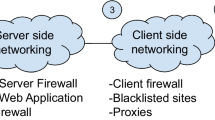Abstract
Cross-Site Scripting (XSS) — around fourteen years old vulnerability is still on the rise and a continuous threat to the web applications. Only last year, 150505 defacements (this is a least, an XSS can do) have been reported and archived in Zone-H (a cybercrime archive) (http://www.zone-h.org/). The online WYSIWYG (What You See Is What You Get) or rich-text editors are now a days an essential component of the web applications. They allow users of web applications to edit and enter HTML rich text (i.e., formatted text, images, links and videos etc.) inside the web browser window. The web applications use WYSIWYG editors as a part of comment functionality, private messaging among users of applications, blogs, notes, forums post, spellcheck as-you-type, ticketing feature, and other online services. The XSS in WYSIWYG editors is considered more dangerous and exploitable because the user-supplied rich-text contents (may be dangerous) are viewable by other users of web applications.
In this paper, we present a security analysis of twenty (20) popular WYSIWYG editors powering thousands of web sites. The analysis includes WYSIWYG editors like Enterprise TinyMCE, EditLive, Lithium, Jive, TinyMCE, PHP HTML Editor, markItUp! universal markup jQuery editor, FreeTextBox (popular ASP.NET editor), Froala Editor, elRTE, and CKEditor. At the same time, we also analyze rich-text editors available on very popular sites like Twitter, Yahoo Mail, Amazon, GitHub and Magento and many more. In order to analyze online WYSIWYG editors, this paper also present a systematic and WYSIWYG editors’s specific XSS attack methodology. We apply the XSS attack methodology on online WYSIWYG editors and found XSS is all of them. We show XSS bypasses for old and modern browsers. We have responsibly reported our findings to the respective developers of editors and our suggestions have been added. In the end, we also point out some recommendations for the developers of web applications and WYSIWYG editors.
Access this chapter
Tax calculation will be finalised at checkout
Purchases are for personal use only
Similar content being viewed by others
Notes
- 1.
- 2.
- 3.
- 4.
http://www.tinymce.com/develop/bugtracker_view.php?id=6855|6851|6858.
- 5.
- 6.
References
Google Vulnerability Reward Program Report for year 2013.: https://www.youtube.com/watch?v=oAYjZy1Nuyg
Google Trends.: http://www.google.com/trends/explore#q=XSS%2C%20SQL%20Injection&date=today%2012-m&cmpt=q
TweetDeck ShutDown.: https://twitter.com/TweetDeck/status/476770732987252736
Jive.: http://www.jivesoftware.com/why-jive/customers/#view=list
TinyMCE Tracker.: http://www.tinymce.com/develop/bugtracker.php
Lithium.: http://www.lithium.com/why-lithium/customer-success/
Froala.: https://github.com/stefanneculai/froala-wysiwyg/issues/33#issuecomment-41170451
Froala Editor.: http://editor.froala.com/
Edit Live.: http://ephox.com/customers
Markdown.: http://daringfireball.net/projects/markdown/
From “I wonder...” to Exploitable Worm in 96 Minutes.: https://storify.com/pacohope/from-i-wonder-to-exploitable-worm
Content Security Policy 1.1.: http://www.w3.org/TR/CSP11/
Heiderich, M., Frosch, T., Jensen, M., Thorsten, H.: Security risks of scalable vectors graphics. In: CCS, Crouching Tiger - Hidden Payload (2011)
Heiderich, M., Schwenk, J., Frosch, T., Magazinius, J., Yang, E.Z.: mXSS attacks: attacking well-secured web-applications by using innerHTML mutations.. In: CCS (2013)
About Dynamic Properties.: http://msdn.microsoft.com/en-us/library/ie/ms537634(v=vs.85).aspx
Play safely in sandboxed IFrames.: http://www.html5rocks.com/en/tutorials/security/sandboxed-iframes/
Author information
Authors and Affiliations
Corresponding author
Editor information
Editors and Affiliations
A List of WYSIWYG Editors
A List of WYSIWYG Editors
-
1.
Mercury Editor: The Rails HTML5 WYSIWYG editor (http://jejacks0n.github.com/mercury)
-
2.
bootstrap-wysihtml5: Simple, beautiful wysiwyg editor (https://github.com/jhollingworth/bootstrap-wysihtml5)
-
3.
KindEditor (http://kindeditor.org/)
-
4.
PHP HTML Editor (http://phphtmleditor.com/demo/)
-
5.
elRTE — an open-source WYSIWYG HTML-editor (http://elrte.org/)
-
6.
medium-editor (https://github.com/daviferreira/medium-editor)
-
7.
TinyMCE (http://www.tinymce.com/)
-
8.
Lithium (http://www.lithium.com/)
-
9.
Jive (http://www.jivesoftware.com/)
-
10.
Froala (http://editor.froala.com/)
-
11.
CKEditor (http://ckeditor.com/)
-
12.
EditLive (http://ephox.com/editlive)
-
13.
jquery.qeditor (https://github.com/huacnlee/jquery.qeditor)
-
14.
mooeditable (http://cheeaun.github.io/mooeditable/)
-
15.
HTML5 WYSIWYG Editor (https://github.com/bordeux/HTML-5-WYSI WYG-Editor)
-
16.
markItUp! universal markup jQuery editor (http://markitup.jaysalvat.com/home/)
-
17.
FreeTextBox HTML Editor (http://www.freetextbox.com/)
-
18.
Markdown (http://daringfireball.net/projects/markdown/)
- 19.
-
20.
Bootstrap Wysihtml5 with Custom Image Insert (https://github.com/rcode5/image-wysiwyg-sample)
Rights and permissions
Copyright information
© 2015 Springer International Publishing Switzerland
About this paper
Cite this paper
Javed, A., Schwenk, J. (2015). Systematically Breaking Online WYSIWYG Editors. In: Rhee, KH., Yi, J. (eds) Information Security Applications. WISA 2014. Lecture Notes in Computer Science(), vol 8909. Springer, Cham. https://doi.org/10.1007/978-3-319-15087-1_10
Download citation
DOI: https://doi.org/10.1007/978-3-319-15087-1_10
Published:
Publisher Name: Springer, Cham
Print ISBN: 978-3-319-15086-4
Online ISBN: 978-3-319-15087-1
eBook Packages: Computer ScienceComputer Science (R0)




